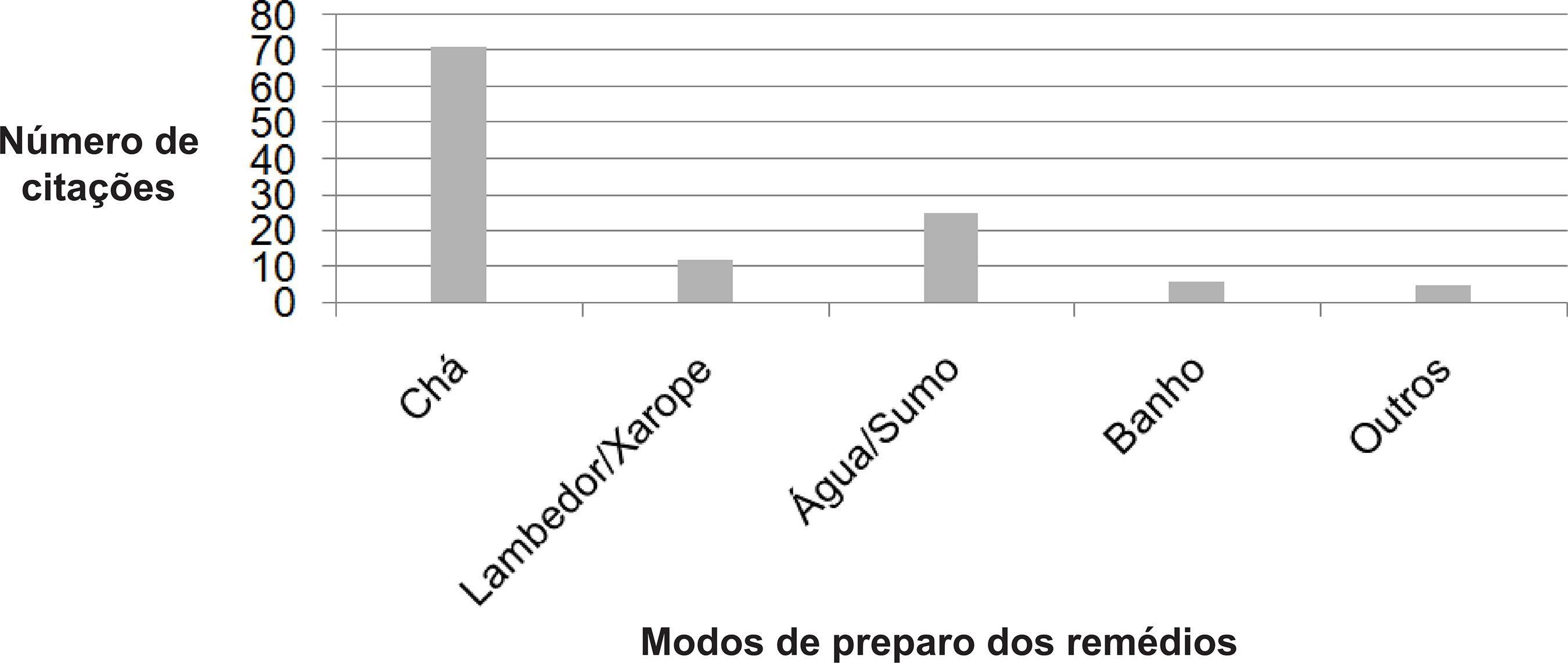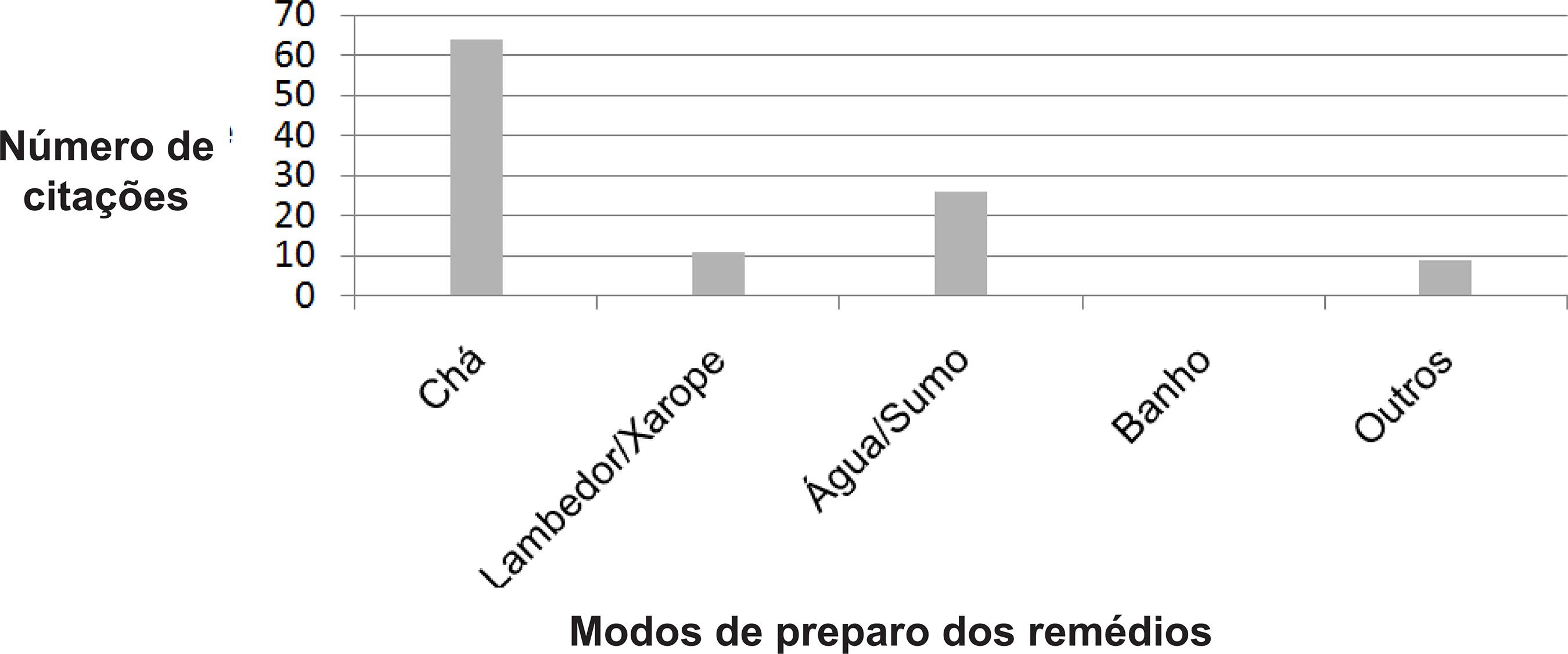| Família |
|
Nome Científico |
|
Nome popular |
|
Parte(s) usada(s) |
|
Forma(s) de uso(s) |
|
Indicação(ões) terapêutica(s) |
|
NI/ PI |
|
Frequência Relativa (≥ 5%) |
| Adoxaceae |
|
Sambucus australis Cham. & Schltdl. |
|
Sabugueiro |
|
Flor |
|
Chá |
|
Febre, sarampo, gripe |
|
4 |
|
- |
| Amaranthaceae |
|
Chenopodium ambrosioides L. |
|
Mastruz |
|
Folha |
|
Chá, lambedor, sumo |
|
Gripe, gastrite, úlcera, ameba |
|
12 |
|
19,6% |
| Amaryllidaceae Allium cepa L. |
|
|
|
Cebola branca |
|
Caule (bulbo) |
|
Lambedor |
|
Gripe |
|
2 |
|
- |
| Amaryllidaceae |
|
Allium sativum L. |
|
Alho |
|
Caule (bulbo) |
|
Chá |
|
Tosse, gripe, vermes, dor de dente, febre |
|
4 |
|
-
|
| Anacardiaceae |
|
Anacardium occidentale L. |
|
Cajueiro |
|
Casca do caule |
|
Água, chá |
|
Ferimentos, inflamações |
|
5 |
|
8,1% |
| Anacardiaceae |
|
Myracrodruon urundeuva Allemão |
|
Aroeira |
|
Casca do caule |
|
Água |
|
Inflamações |
|
2 |
|
- |
| Annonaceae |
|
Annona muricata L. |
|
Graviola |
|
Folha |
|
Chá |
|
Colesterol alto, dor de coluna |
|
1 |
|
- |
| Apiaceae |
|
Anethum graviolens L. |
|
Endril |
|
Semente |
|
Chá |
|
Tosse, dor de barriga |
|
2 |
|
- |
| Apiaceae |
|
Pimpinella anisum L. |
|
Erva doce |
|
Semente |
|
Chá |
|
Calmante |
|
2 |
|
- |
| Asteraceae |
|
Baccharis trimera (Less.) DC. |
|
Carqueja |
|
Folha |
|
Chá |
|
Colesterol alto, obesidade, doenças do estômago |
|
1 |
|
- |
| Asteraceae |
|
Chamomilla recutita (L.) Rauschert |
|
Camomila |
|
Flor |
|
Chá, banho |
|
Calmante, hipertensão, estresse |
|
10 |
|
16,3% |
| Asteraceae |
|
Egletes viscosa (L.) Less. |
|
Macela |
|
Semente, flor |
|
Chá |
|
Vermes, intestino preso |
|
5 |
|
8,1% |
| Asteraceae |
|
Helianthus annuus L. |
|
Girassol |
|
Semente |
|
Chá |
|
Trombose |
|
1 |
|
- |
| Asteraceae |
|
Vernonia condensata Baker |
|
Boldo |
|
Folha |
|
Chá |
|
Barriga inchada, gases, doenças do fígado e do estômago |
|
12 |
|
19,6 % |
| Boraginaceae |
|
Heliotropium elongatum var. burchellii I.M. Johnst. |
|
Fedegoso |
|
Folha, raiz |
|
Chá |
|
Ferimentos, bronquite, problemas pós-parto |
|
6 |
|
9,8% |
| Boraginaceae |
|
Symphytum officinale L. |
|
Confrei |
|
Folha |
|
Lambedor |
|
Inflamações |
|
2 |
|
- |
| Brassicaceae |
|
Nasturtium officinale W.T Ailton |
|
Agrião de remédio |
|
Semente |
|
Chá, lambedor |
|
Dor de garganta, anemia |
|
4 |
|
- |
| Cactaceae |
|
Melocactus zehntneri (Britton & Rose) Luetzelb. |
|
Coroa de frade |
|
Raiz |
|
Sumo |
|
Tosse |
|
2 |
|
- |
| Cactaceae |
|
Opuntia cochenillifera (L.) Mill. |
|
Palma |
|
Raiz |
|
Chá |
|
Tosse, bronquite |
|
2 |
|
- |
| Celastraceae |
|
Maytenus officinalis Mabb. |
|
Espinheira santa |
|
Folha |
|
Chá |
|
Gastrite |
|
1 |
|
- |
| Cleomaceae |
|
Tarenaya spinosa (Jacq.) Raf. |
|
Mussambê |
|
Flor, raiz |
|
Chá, lambedor |
|
Gripe, inflamações |
|
1 |
|
- |
| Crassulaceae |
|
Bryophyllum pinnatum (Lam.) Oken |
|
Corama |
|
Folha |
|
Lambedor |
|
Inflamação, infecções |
|
2 |
|
- |
| Cucurbitaceae |
|
Apodanthera congestiflora Cogn. |
|
Cabeça de nego |
|
Raiz |
|
Lambedor |
|
Dores gerais |
|
2 |
|
- |
| Cucurbitaceae |
|
Luffa operculata (L.) Cogn. |
|
Cabacinha |
|
Fruto |
|
Infusão (inalação do vapor) |
|
Sinusite |
|
1 |
|
- |
| Euphorbiaceae |
|
Croton blanchetianus Baill. |
|
Marmeleiro |
|
Casca do caule |
|
Sumo |
|
Dor de barriga |
|
2 |
|
- |
| Euphorbiaceae |
|
Croton heliotropiifolius Kunth |
|
Velame |
|
Raiz |
|
Chá |
|
Tosse |
|
3 |
|
- |
| Euphorbiaceae |
|
Croton nepetifolius Baill. |
|
Marmeleiro branco |
|
Casca do caule |
|
Pó |
|
Hemorragias |
|
1 |
|
- |
| Fabaceae |
|
Amburana cearensis (Allemão) A.C. Sm. |
|
Cumarú, imburana de cheiro |
|
Casca do caule, folha, semente |
|
Água, lambedor, banho, chá |
|
Sinusite, trombose, dores |
|
7 |
|
11,4% |
| Fabaceae |
|
Anadenanthera colubrina (Vell.) Brenan |
|
Angico |
|
Casca do caule |
|
Água, lambedor |
|
Dores musculares |
|
2 |
|
- |
| Fabaceae |
|
Bauhinia cheilantha (Bong.) Steud. |
|
Mororó |
|
Casca do caule |
|
Água |
|
Diabetes, dor de coluna, colesterol alto |
|
3 |
|
- |
| Fabaceae |
|
Bowdichia virgilioides Kunth |
|
Sucupira |
|
Semente |
|
Infusão, água |
|
Sinusite, dor de coluna, dor de garganta |
|
2 |
|
- |
| Fabaceae |
|
Hymenaea courbaril var. villosa Y.T Lee & Andrade-Lima |
|
Jatobá |
|
Casca do caule, fruto |
|
Lambedor, água, Chá |
|
Anemia, infecção urinária |
|
5 |
|
8,1% |
| Fabaceae |
|
Mimosa tenuiflora (Willd.) Poir. |
|
Jurema preta |
|
Casca do caule |
|
Pó |
|
Ferimentos |
|
2 |
|
- |
| Fabaceae |
|
Poincianella pyramidalis (Tul.) L.P. Queiroz |
|
Catingueira |
|
Flor |
|
Chá |
|
Tosse, bronquite |
|
1 |
|
- |
| Fabaceae |
|
Senna obtusifolia (L.) H.S. Irwin & Barneby |
|
Mata pasto |
|
Raiz |
|
Chá |
|
Dor de barriga |
|
1 |
|
- |
| Lamiaceae |
|
Mentha x villosa Huds. |
|
Hortelã miúda |
|
Folha |
|
Chá, lambedor, sumo |
|
Expectorante, vermes, ameba, giárdia, infecção intestinal |
|
10 |
|
16,3% |
| Lamiaceae |
|
Plectranthus amboinicus (Lour.) Spreng. |
|
Hortelã da folha grossa |
|
Folha |
|
Lambedor, chá |
|
Gripe, tosse, inflamação no útero |
|
6 |
|
9,8% |
| Lamiaceae |
|
Vitex gardneriana Schauer |
|
Jaramataia |
|
Folha |
|
Chá, água |
|
Doenças da próstata |
|
3 |
|
- |
| Lauraceae |
|
Persea americana Mill. |
|
Abacate |
|
Folha |
|
Asseio |
|
Hemorroidas |
|
1 |
|
- |
| Linaceae |
|
Linum usitatissimum L. |
|
Linhaça |
|
Semente |
|
Água |
|
Colesterol alto, imunidade baixa |
|
1 |
|
- |
| Lythraceae |
|
Punica granatum L. |
|
Romã |
|
Cascas do caule, raiz, folha |
|
Água |
|
Ganganta inflamada, gripe |
|
6 |
|
9,8% |
| Malvaceae |
|
Gossypium hirsutum L. |
|
Algodão |
|
Semente, flor |
|
Chá, emplasto |
|
Febre, tumor (furúnculo), intestino preso |
|
3 |
|
- |
| Malvaceae |
|
Sida cordifolia L. |
|
Malva rosa |
|
Folha |
|
Chá |
|
Tosse |
|
3 |
|
- |
| Myrtaceae |
|
Eucalyptus globulus Labill. |
|
Eucalipto |
|
Folha |
|
Chá, banho |
|
Gripe, febre, expectorante |
|
6 |
|
9,8% |
| Myrtaceae |
|
Psidium guajava L. |
|
Goiabeira |
|
Flor |
|
Chá |
|
Diarreia |
|
1 |
|
- |
| Oleaceae |
|
Olea europaea L.
|
|
Azeitona |
|
Folha |
|
Chá |
|
Colesterol alto |
|
1 |
|
- |
| Passifloraceae |
|
Passiflora edulis Sims |
|
Maracujá |
|
Casca do fruto |
|
Pó |
|
Diabetes, calmante |
|
2 |
|
- |
| Passifloraceae |
|
Turnera subulata Sm. |
|
Chanana |
|
Raiz, folha |
|
Chá, infusão |
|
Infecção urinária, problemas na próstata, inflamações |
|
1 |
|
- |
| Phyllanthaceae |
|
Phyllanthus niruri L. |
|
Quebra pedra |
|
Raiz |
|
Chá, água |
|
Pedra nos rins |
|
6 |
|
9,8% |
| Piperaceae |
|
Piper nigrum L. |
|
Pimenta do reino |
|
Folha |
|
Chá |
|
Febre |
|
1 |
|
- |
| Plantaginaceae |
|
Plantago major L. |
|
Tansagem |
|
Semente, folha |
|
Chá, sumo |
|
Expectorante, garganta inflamada. |
|
4 |
|
- |
| Poaceae |
|
Cymbopogon citratus (DC.) Stapf |
|
Capim santo |
|
Folha |
|
Chá |
|
Calmante, vermes |
|
6 |
|
9,8% |
| Rutaceae |
|
Citrus aurantiifolia (Christm.) Swingle |
|
Limão |
|
Folha |
|
Chá |
|
Gripe |
|
1 |
|
- |
| Rutaceae |
|
Citrus sinensis (L.) Osbeck |
|
Laranja |
|
Folha |
|
Chá |
|
Calmante |
|
2 |
|
- |
| Rutaceae |
|
Ruta graveolens L. |
|
Arruda |
|
Folha |
|
Chá |
|
Dor de ouvido, diarreia, varizes |
|
2 |
|
- |
| Sapotaceae |
|
Sideroxylon obtusifolium (Humb. ex Roem. & Schult.) T.D. Penn. |
|
Quixabeira |
|
Casca do caule |
|
Água, banho |
|
Inflamações |
|
2 |
|
- |
| Schisandraceae |
|
Illicium verum Hook. f. |
|
Anis |
|
Flor |
|
Chá |
|
Prisão de ventre |
|
1 |
|
- |
| Theaceae |
|
Camellia sinensis (L.) Kuntze |
|
Chá preto |
|
Folha |
|
Chá, infusão, compressa |
|
Má digestão, febre, dor de cabeça |
|
5 |
|
8,1% |
| Verbenaceae |
|
Lippia alba (Mill.) N.E. Br. ex Britton & P. Wilson |
|
Erva cidreira |
|
Folha |
|
Chá |
|
Má digestão, calmante, hipertensão |
|
10 |
|
16,3% |
| Verbenaceae |
|
Lippia microphylla Cham. |
|
Alecrim |
|
Folha, casca do caule |
|
Infusão |
|
Doenças do coração, hipertensão, dores musculares |
|
4 |
|
- |
| Violaceae |
|
Hybanthus calceolaria (L.) Oken |
|
Papaconha |
|
Raiz |
|
Chá |
|
Fraqueza |
|
2 |
|
- |
| Xanthorrhoeaceae |
|
Aloe vera (L.) Burm. f. |
|
Babosa |
|
Folha |
|
Sumo (aplicado no local), água |
|
Câncer, ameba |
|
2 |
|
- |
| Ximeniaceae |
|
Ximenia americana fo. Inermis (Aubl.) Engl. |
|
Ameixa |
|
Casca do caule |
|
Pó, água |
|
Ferimentos, queimaduras |
|
2 |
|
- |
| Zingiberaceae |
|
Alpinia speciosa (Blume) D. Dietr. |
|
Colônia |
|
Folha |
|
Chá |
|
Doenças do coração |
|
2 |
|
- |







